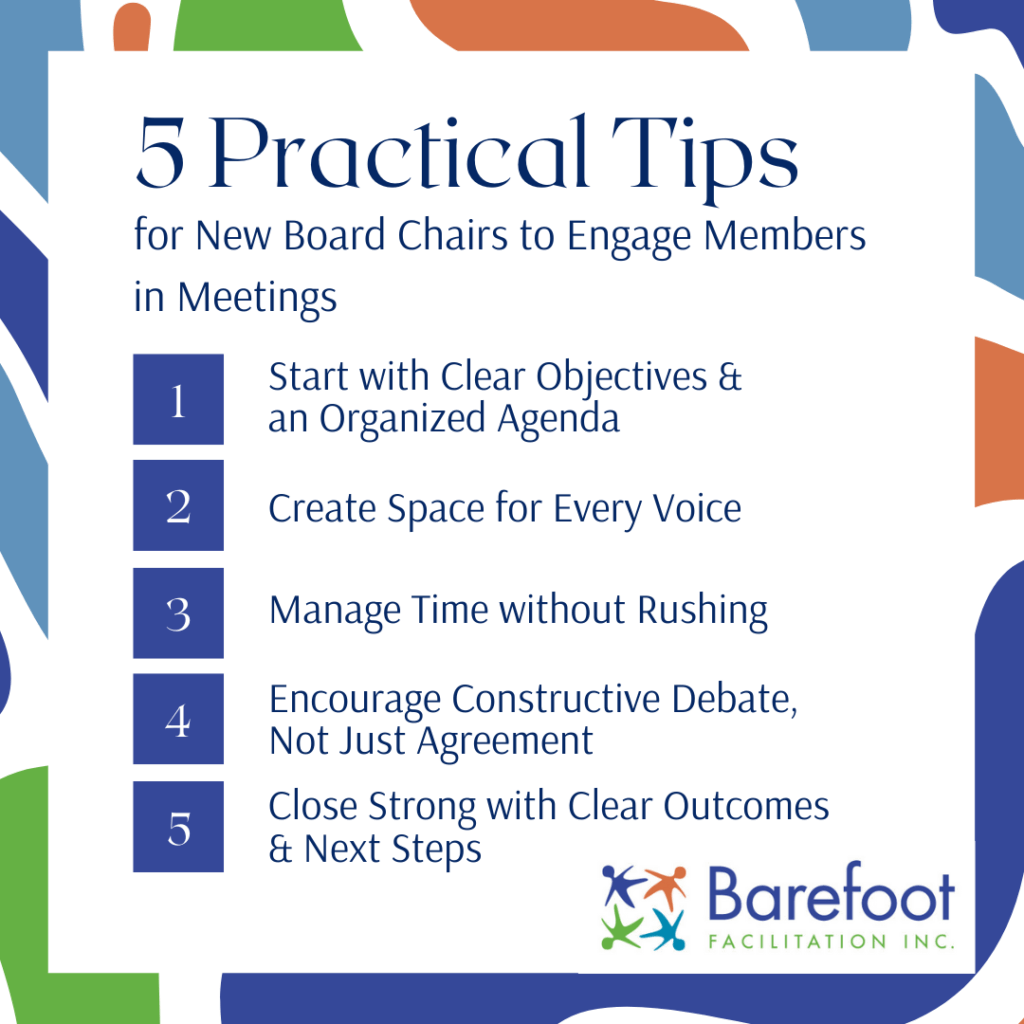May 2025
Stepping into the role of Board Chair is both an honour and a responsibility. You set the tone, guide the discussion, and help ensure that your Board remains focused, strategic, and effective. But if you’re new to facilitation, leading meetings can feel overwhelming – especially when trying to engage a diverse group of Board members with different personalities, backgrounds, and priorities.

Here are five practical tips to help you run effective, engaging Board meetings, even if you’re still building your confidence as a facilitator.
1. Start with Clear Objectives and an Organized Agenda
A well-prepared agenda is your best friend. Make sure it’s shared with the Board at least a week before the meeting. Identify which items are for discussion, decision, or simply information. When members know what to expect, they come better prepared to contribute.
Tip: Start each meeting by briefly stating the objectives. For example, “Today we need to align on our funding priorities for next year and decide on the new committee structure.”
2. Create Space for Every Voice
Not all Board members are equally vocal, but that doesn’t mean they have less to offer. Part of your role is to ensure everyone has a chance to contribute. After someone makes a point, pause and ask, “Who has a different perspective?” or “Let’s hear from someone who hasn’t spoken yet.”
Tip: Consider a quick roundtable check-in at the start of the meeting to get everyone speaking early. It sets a collaborative tone and builds comfort for further participation.
3. Manage Time Without Rushing
Board discussions can veer off track or get stuck in detail. As Chair, it’s your job to keep the group focused and on time, without shutting down meaningful conversation. Use time cues gently – “We’ve got 10 more minutes for this item. Are we close to a decision, or do we need to revisit this at our next meeting?”
Tip: Appoint a timekeeper or use a visible timer to keep everyone mindful of pacing.
4. Encourage Constructive Debate, Not Just Agreement
Healthy disagreement leads to better decisions. Create an atmosphere where it’s okay to challenge ideas respectfully. If you sense groupthink or uncritical agreement, ask strategic questions like, “What risks might we be overlooking?” or “What’s the downside of this approach?”
Tip: Normalize respectful debate by modeling it yourself. Acknowledge opposing views without shutting them down.
5. Close Strong with Clear Outcomes and Next Steps
A productive meeting ends with clarity. Summarize decisions, actions, and who’s responsible for what. This avoids confusion and keeps momentum between meetings.
Tip: Send a short follow-up email with key points and responsibilities. This reinforces accountability and shows that the Board’s time is valued.
Final Thought
You don’t need to be a professional facilitator to lead engaging and effective Board meetings. With thoughtful preparation, a few inclusive techniques, and a focus on clarity and participation, you can create a Board culture that’s energized, collaborative, and high-performing.
Your leadership at the head of the table matters – so lead with curiosity, structure, and respect. The results will speak for themselves!
Gerard Murphy
Founder and CEO
Barefoot Facilitation Inc.
